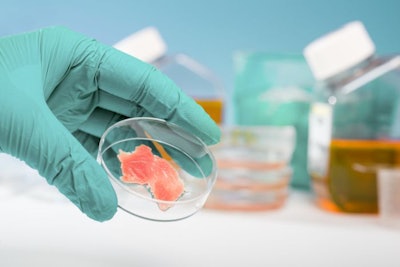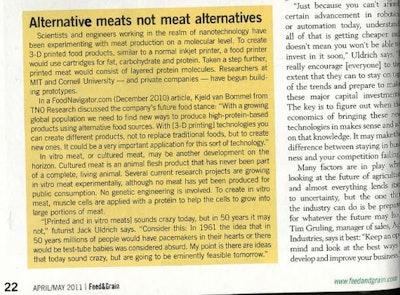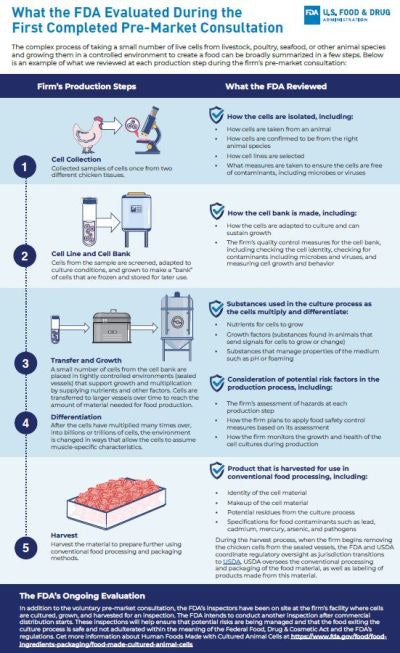
Lab-grown meat technology may challenge traditional animal ag sooner than you think
In 2011, when I was the editor of Feed & Grain magazine, I wrote a special report marking the magazine’s 50th anniversary. The feature centered around predictions of the future of agriculture, i.e. what the industry may look like 50 years from now. In additional to grain and feed industry leaders, I also spoke with futurist Jack Uldrich. Aside from the major technology trends on the horizon, Uldrich also reported that “lab-grown meats” would become a reality, and possibly a major disruptor to animal production.
With this being the most novel prognostication to come from the interviews for that piece, I ran a brief recap of his cell-cultured meat insights as a sidebar — but not without pushback from a skeptical publisher. Seemed far-fetched at the time, didn’t it?

Flash-forward more than a decade to November 2022 when the U.S. Food & Drug Administration (FDA) issued its first approval of lab-grown chicken from cultured cells: The future is now.
Once the technology advances, regulatory hurdles are removed and production scales, how much market share could these real-albeit-grown-by-artificial-means meat products take from traditional animal meat production?
Maybe a lot.
By 2040, market analyst firm Research and Markets suggests 60% of meat will be created from cells grown within bioreactors and sold globally in grocery stores and restaurants.
While cultured meat may still seem like something out of futuristic science-fiction film, here’s what you need to know:
What is cell-cultured meat?
Cell-cultured, or lab-grown, meat is derived from animal cell cultures designed to mimic the taste, texture and appearance of real animal meat products. The original animal cells can be collected from biopsy, a cell bank or from a fresh piece of meat.
To get the cells to multiply and turn into a finished meat product, they are then “fed” a nutrient-rich culture medium — comprised of amino acids, sugars, trace minerals and vitamins — and grown in stainless-steel tanks called bioreactors.

Here’s how the safety consultation of Upside’s cultivated chicken was conducted by the FDA (left). This infographic also gives insight into how cell-cultivated meat is produced. (Courtesy FDA)
What’s the appeal?
Companies can produce meat products — truly animal meat — without slaughtering animals, alleviating the ethical issues surrounding meat consumption. In addition, without the inputs needed to raise poultry and livestock, there could be a serious environmental benefit and alignment with climate-friendly sustainability goals.
In fact, “advocates of cultured meat say that the process is more efficient, flexible and consistent than traditional agriculture,” my colleague Elizabeth Doughman, editor of Poultry Future reports. (If you’re interested in this topic and other forward-looking content, consider subscribing to the Poultry Future newsletter if you don’t already.)
Without slaughterhouses or exposure to pathogens, the food safety element is also intriguing because cultured meat products could eliminate the risk of foodborne illnesses caused by contaminated meat.
Curious about all the players in the alternative protein space? KindEarth.Tech provides a detailed, dynamic ‘New Protein’ map.
What’s the status of cultured meats for human consumption?
The FDA issued the first approval or “no further questions” to Upside Foods (formerly Memphis Meats) regarding the safety of its animal cell culture technology for human consumption; however, further approvals from the FDA and The U.S. Department of Agriculture’s (USDA) Food Safety and Inspection Service (FSIS) are required before it can be sold in the U.S.
In late 2020, Singapore was the first and only other market to issue regulatory approval for Eat Just Inc.’s lab-grown chicken nuggets. (See GOOD Meat, the brand name, to deep dive what it looks like and how it is produced.)
Why you, an animal feed industry stakeholder, should care?
If you’re still giving me the side-eye after reading the factoids I just presented, consider this. We’re at the confluence of several mega trends that could accelerate the adoption and production of cultured meats in the next 10 to 20 years: rapidly evolving technologies; internationally accepted efforts to reduce carbon emissions, prompting moves and pledges to combat climate change; and the ubiquity of flexitarians, i.e. consumers who see all types of protein — farmed, plant-based or, in this case, lab-grown — as just protein and will eat it. (I would also factor in the social, environmentally focused and ethical attitudes, values and buying behaviors of Gen Z into this equation, as it makes the future popularity of no-kill meat look extra viable. But as the kids say, I’m just “going on vibes” with this one.)
Putting the creation of production infrastructure and regulations aside, the biggest obstacles facing the cultured meat producers and consumer adoption will, down the road, be price. Will it be competitive against real animal proteins? Sources suggest it will be. While not the cheapest option, sources suggest the cost of a piece of cultivated chicken will be comparable to premium chicken prices.
So, while the widespread availability of cell-cultured meat alternatives may seem far away, it would be prudent to entertain what this could mean for animal agriculture and feed production in the future.
Fun facts about cultivated meat
- There are 99 companies worldwide developing cultured meat components, services and end products, compared with only four in 2016.
- In the past 12 months, the flow of capital into the cultured meat industry reached approximately US$1 billion.
- The cultured meat industry also witnessed its first public-sector research and development funding awards within the U.S. and the European Union, and China signed a US$300 million deal to buy lab-grown meat produced in Israel in a deal that openly signals its intent to supply cultured meat to its population of 1.4 billion.
- Recent surveys indicate that nearly 50% of the consumers do not have any reservations about cultured meat.
Source: Research and Markets
Feed Mill of the Future digital supplement
WATT’s feed brands Feed Strategy and Feed & Grain magazines join forces to launch the monthly Feed Mill of the Future digital supplement. Each edition aims to provide animal feed industry stakeholders with forward-looking content, market insights and a spotlight on the leading-edge technologies shaping the global feed industry of tomorrow.
Subscribe today! https://bit.ly/3dWzow7












